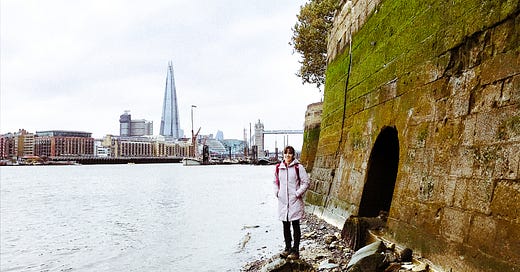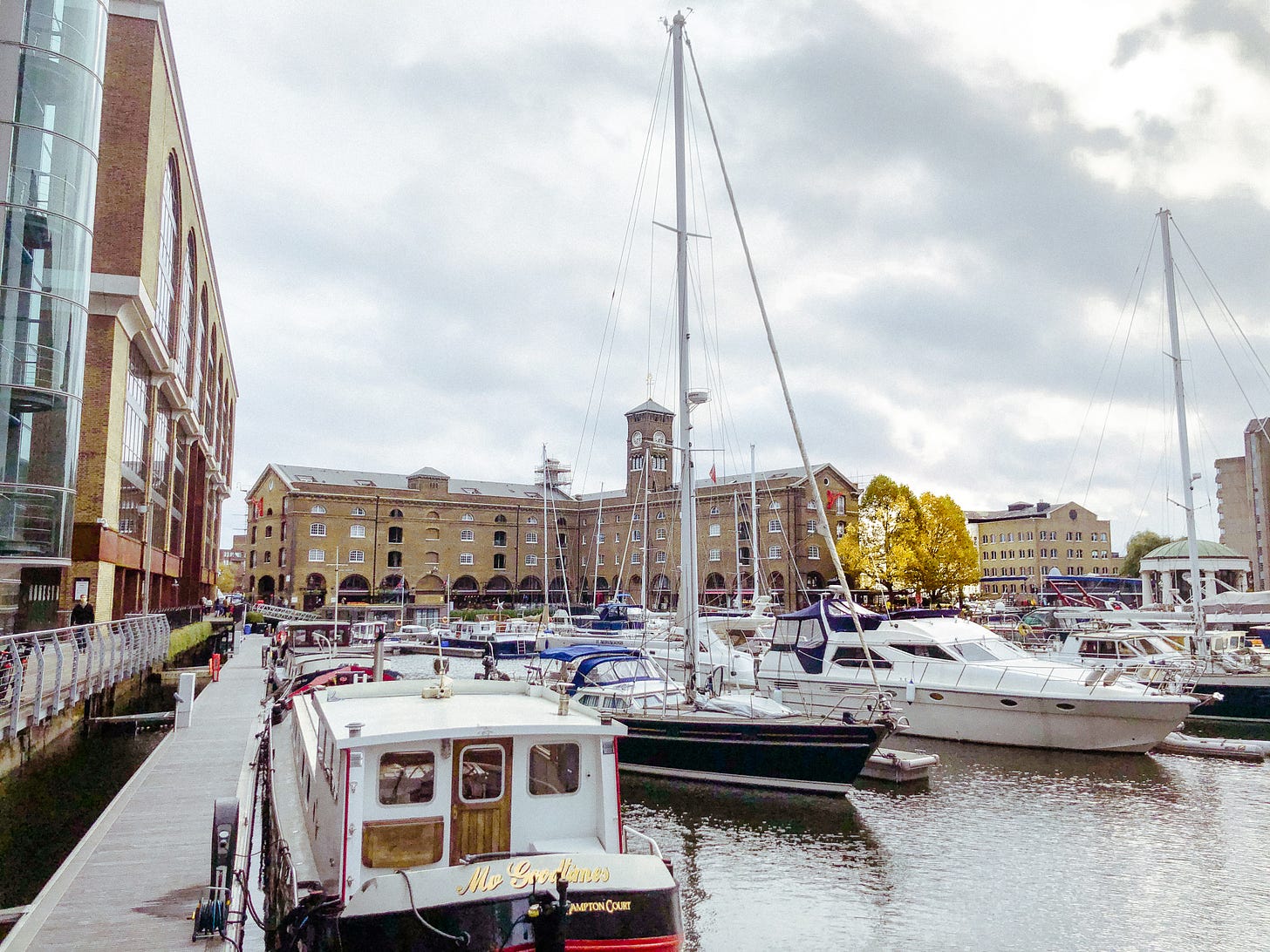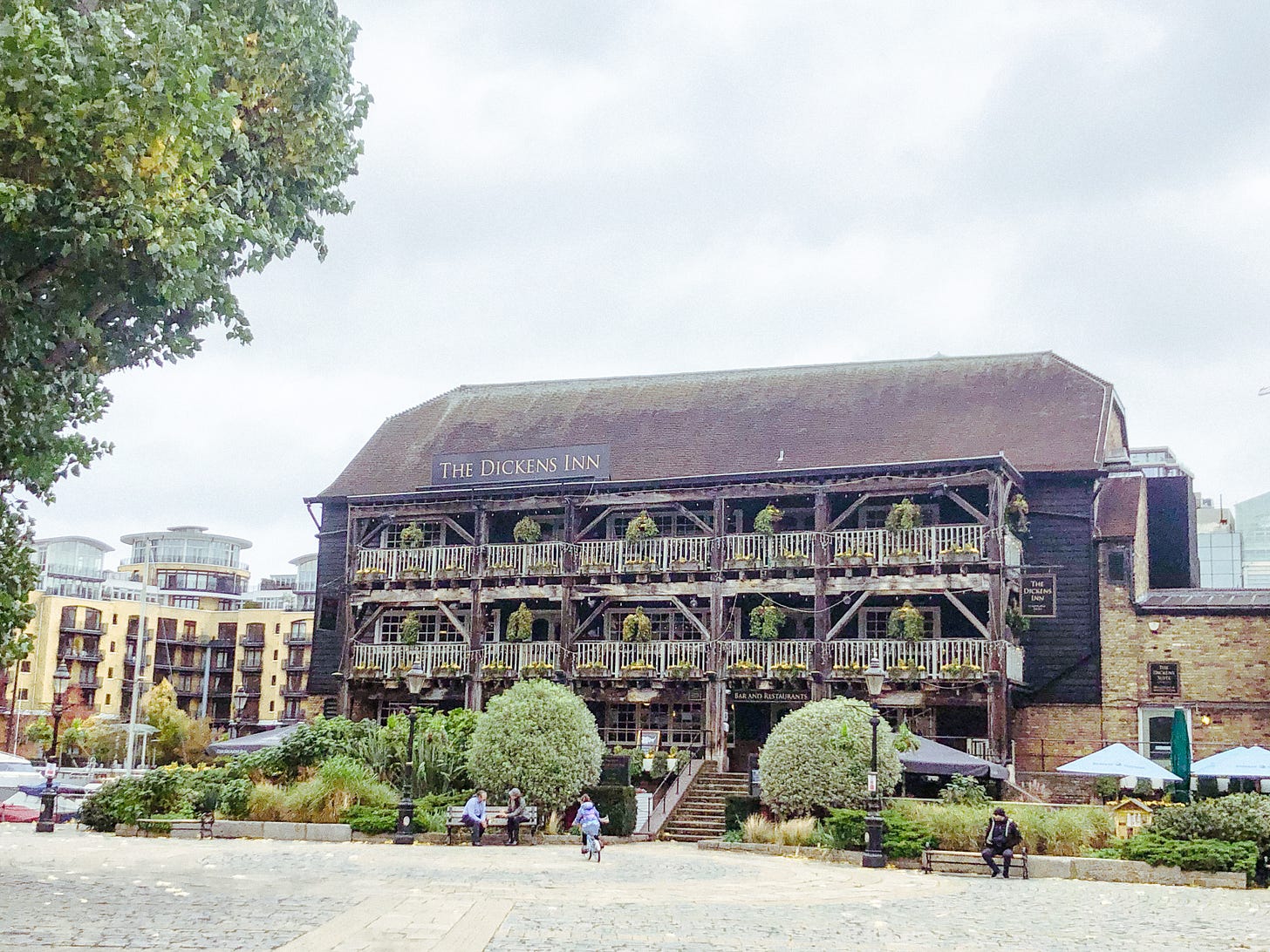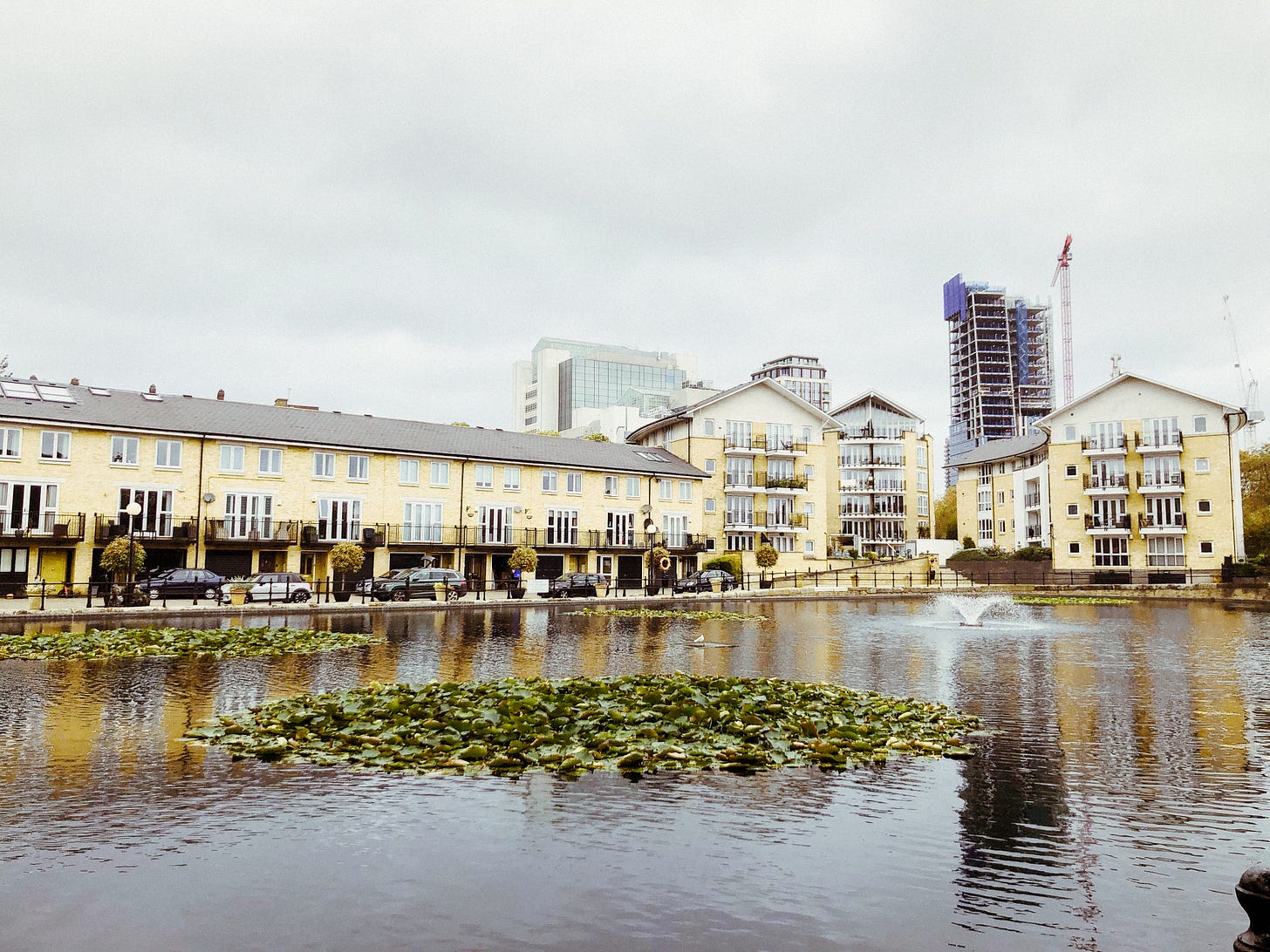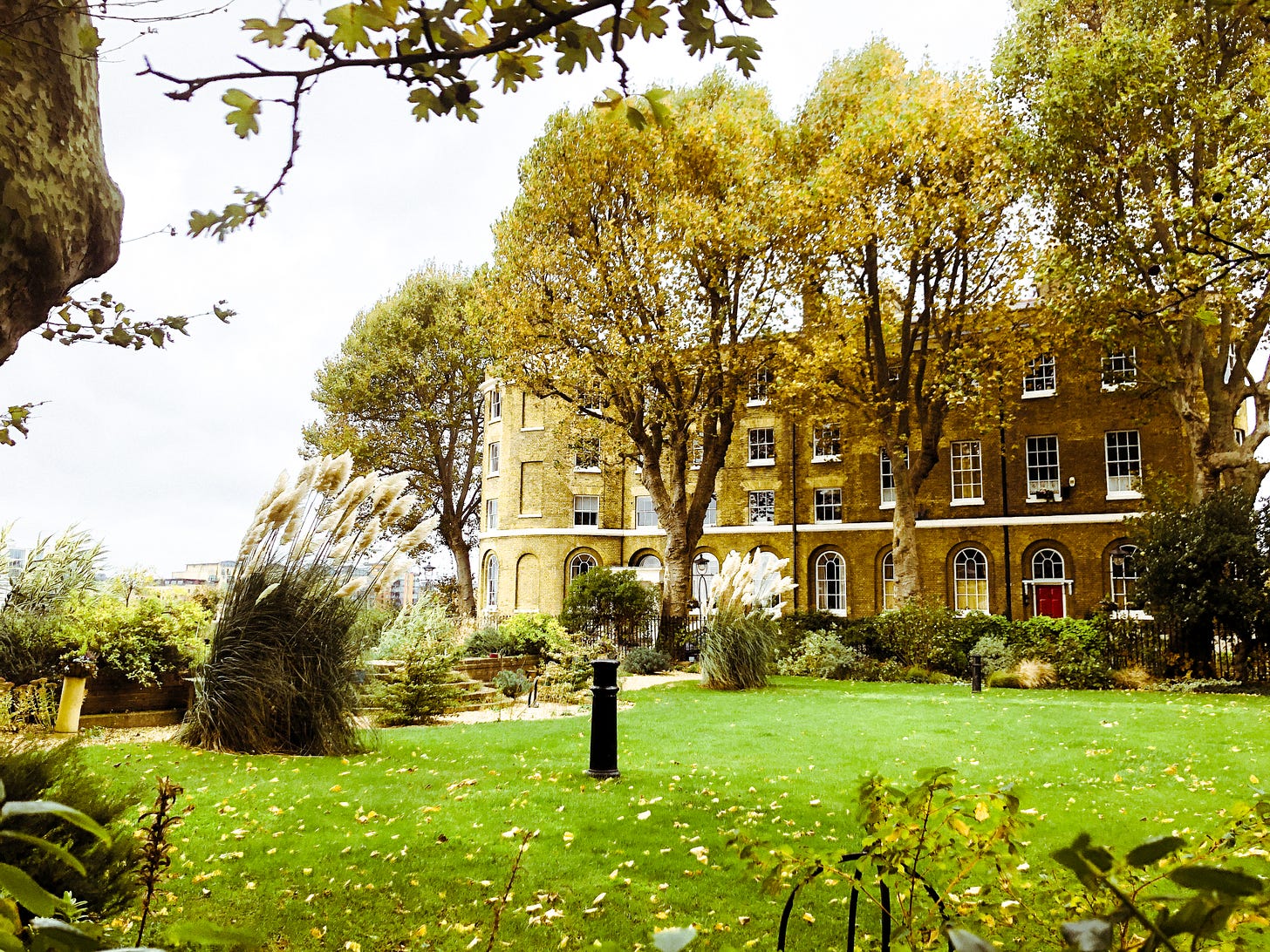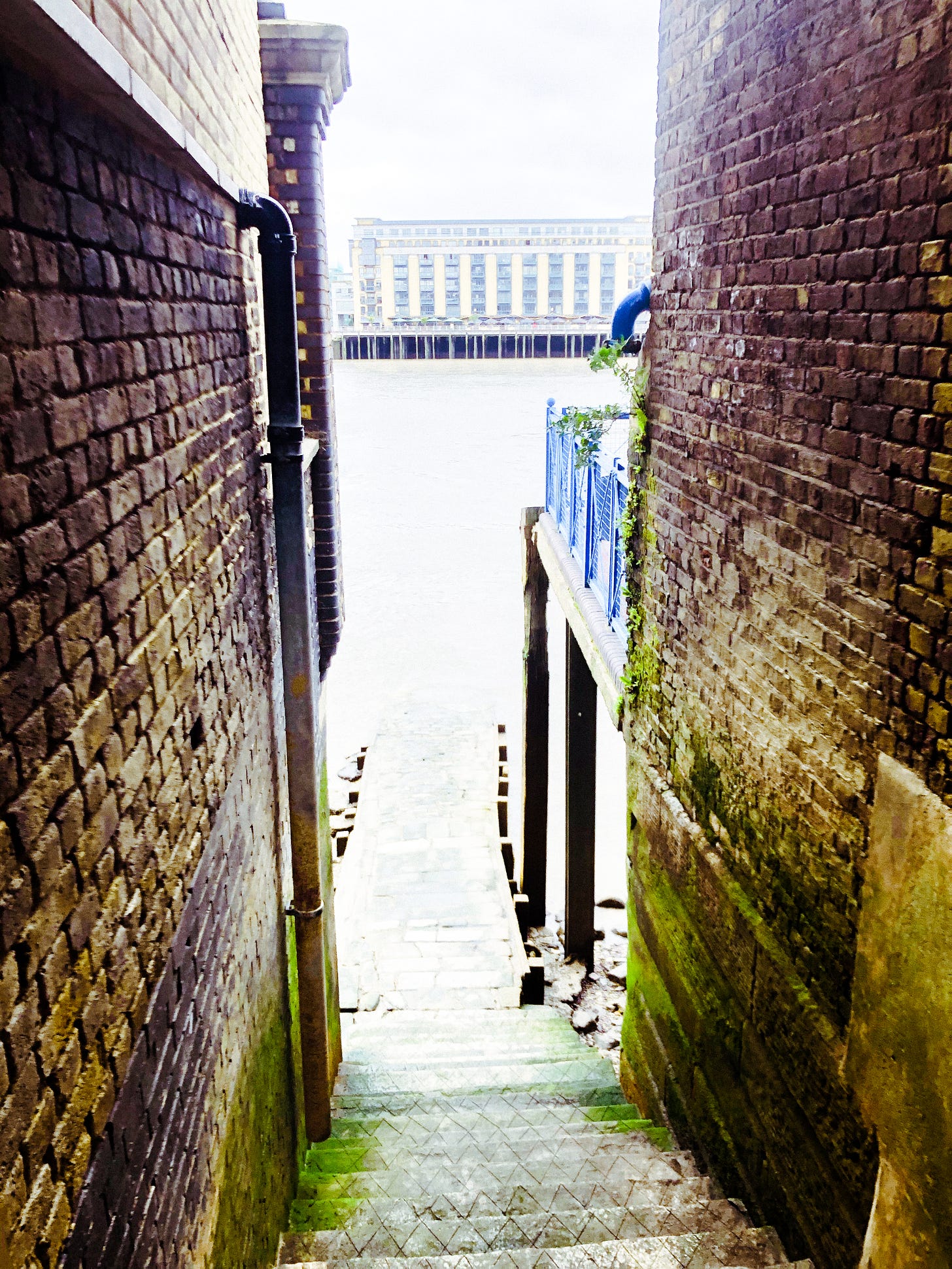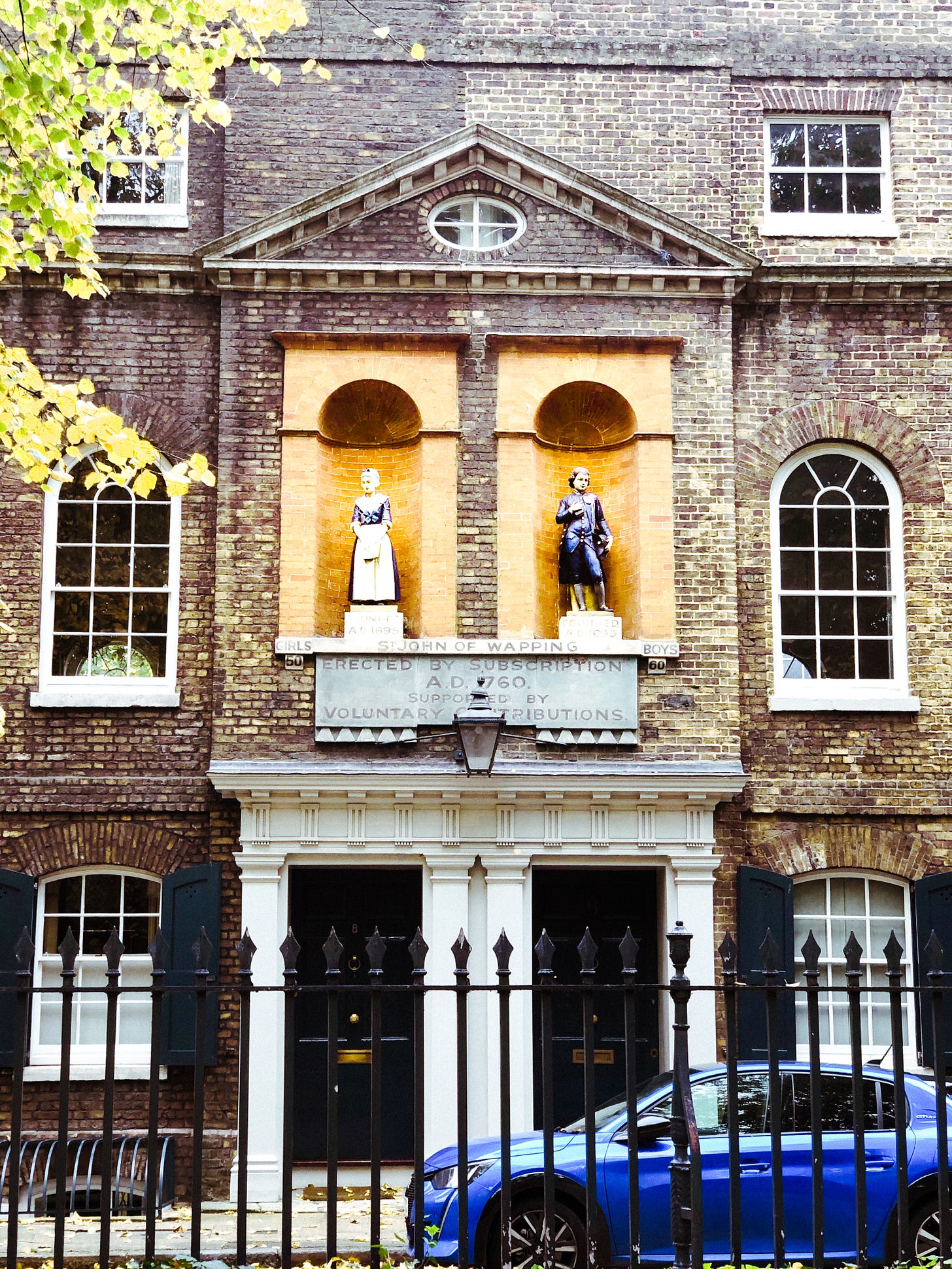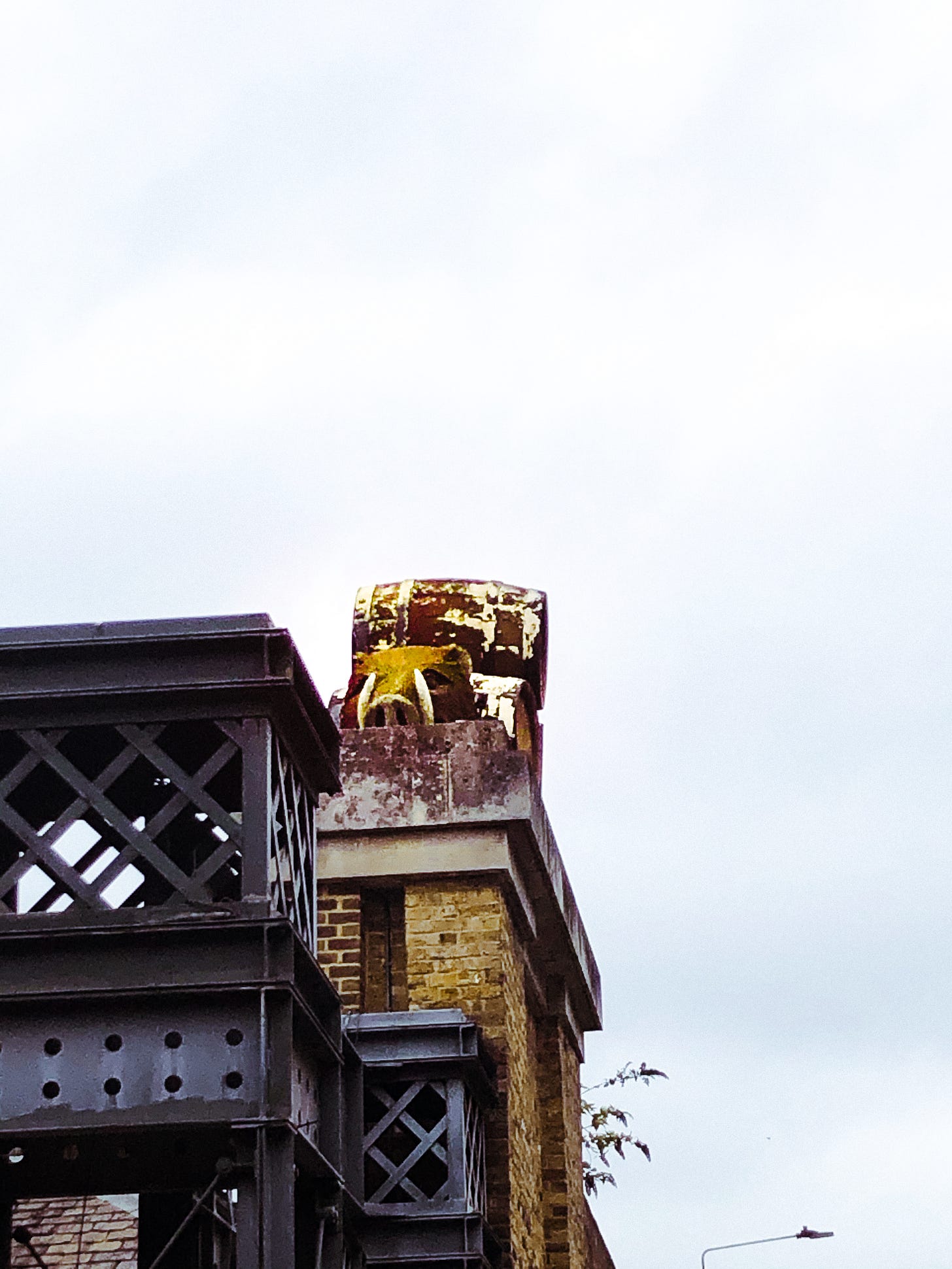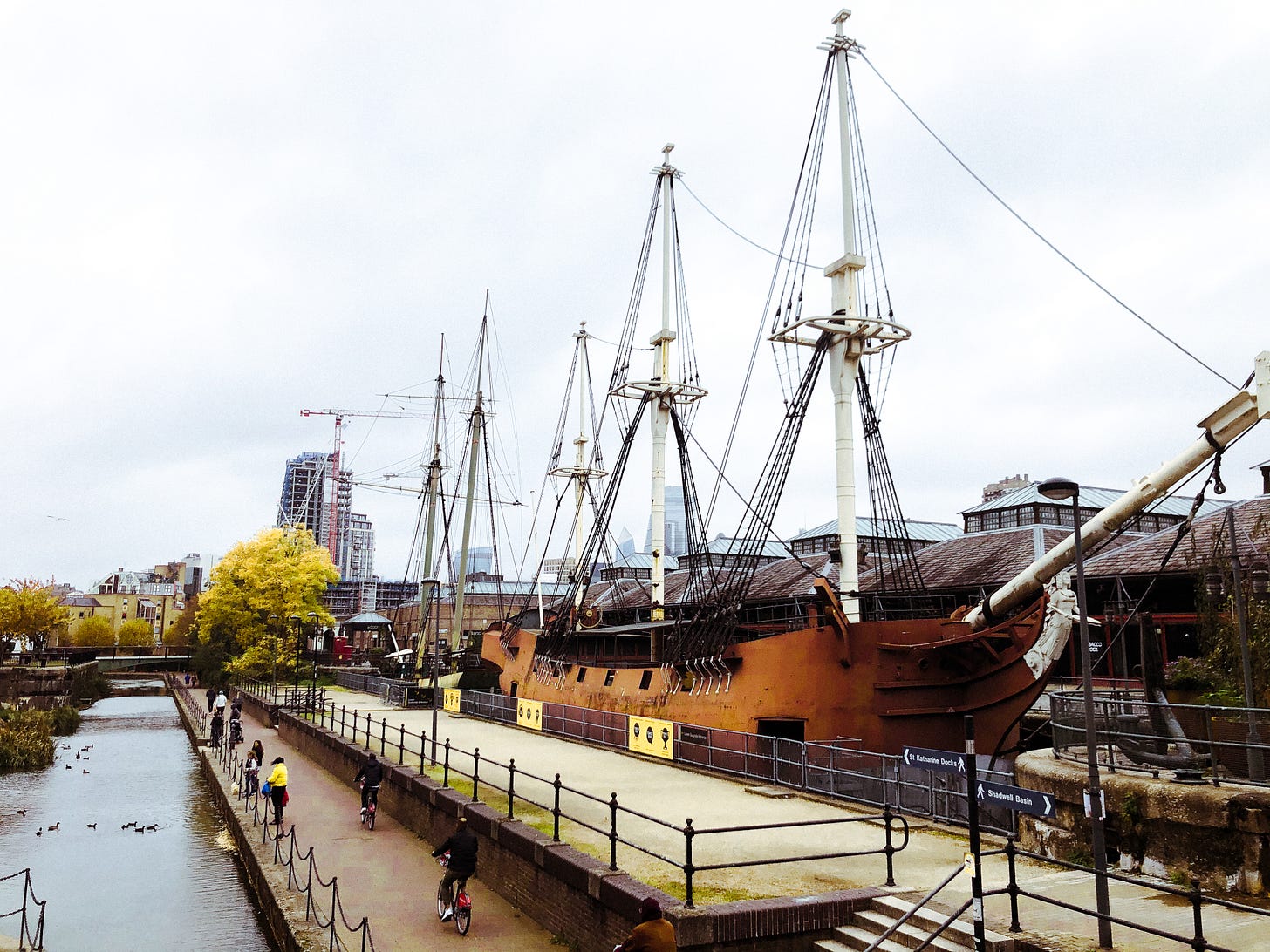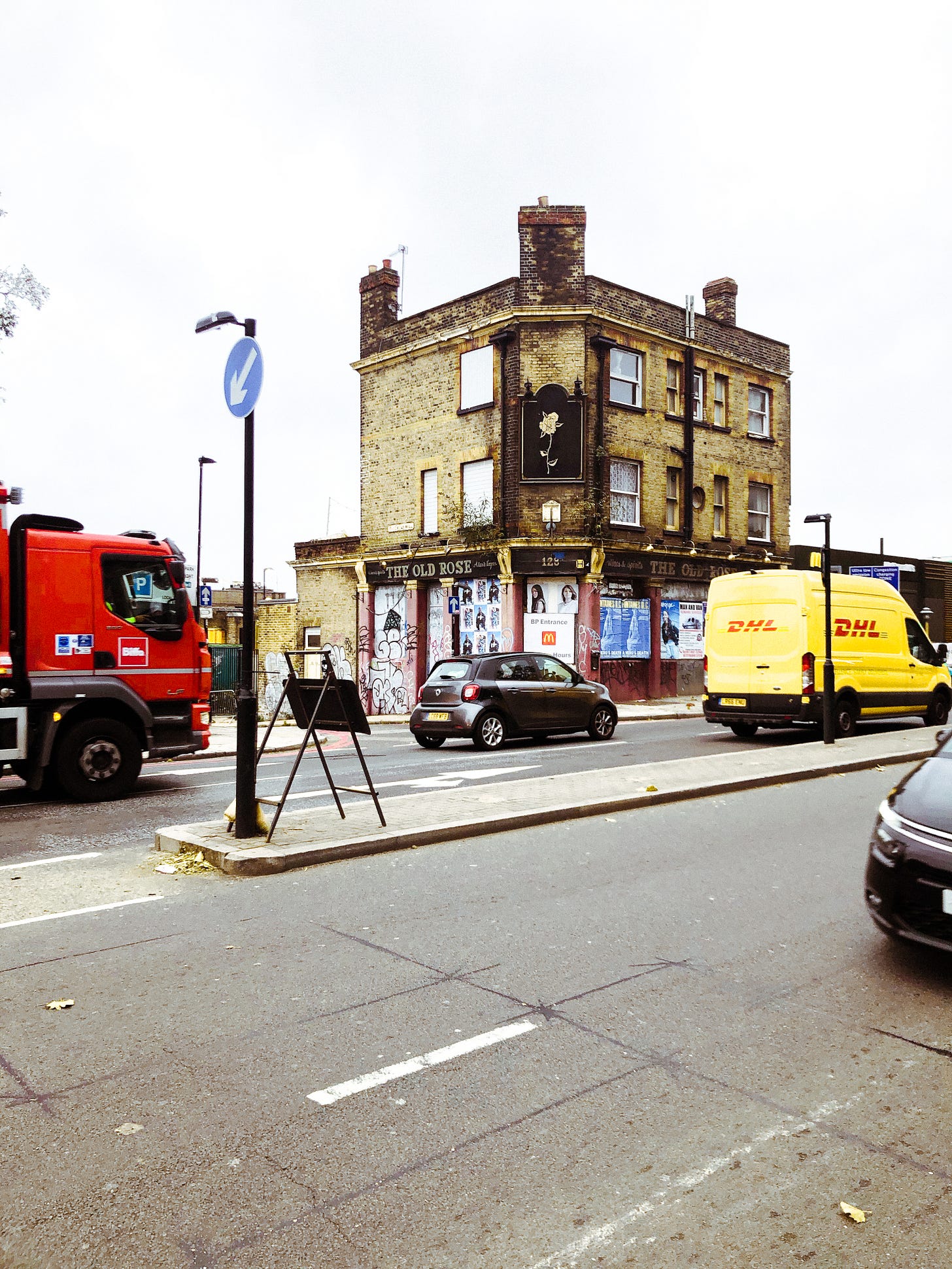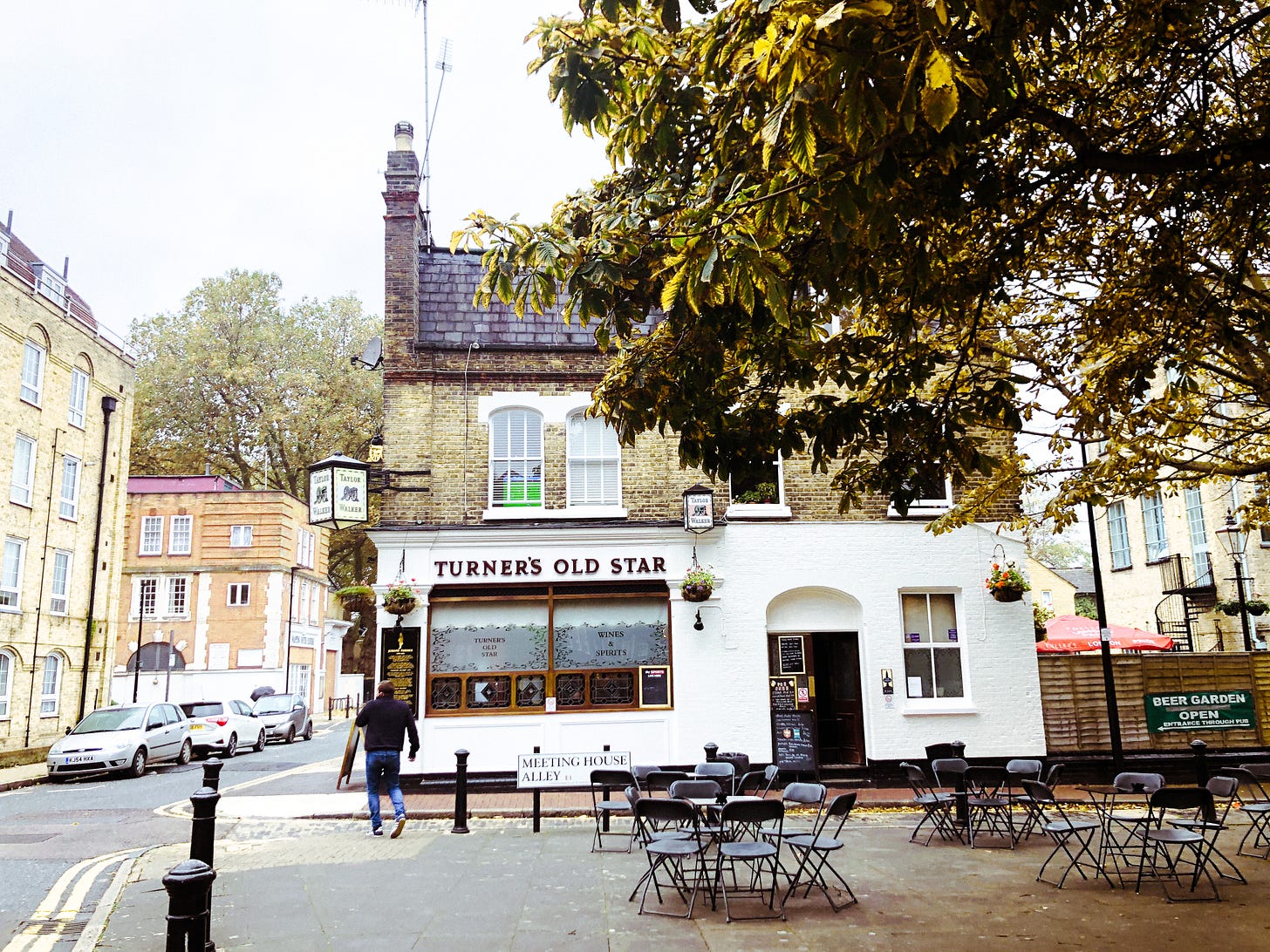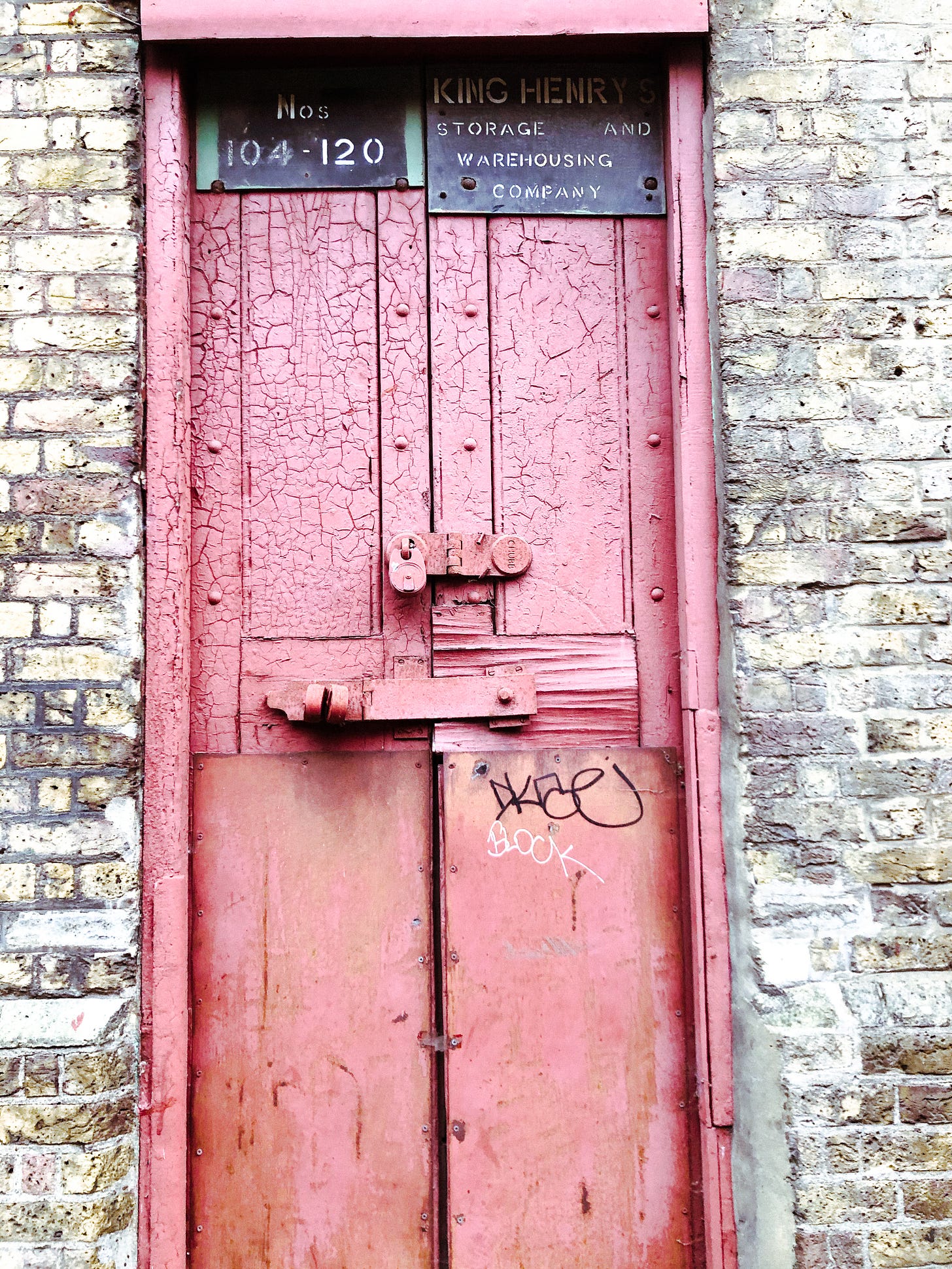Brutal murders, slippery stairs and convicts on their way to Australia: London Docklands, Wapping
Once the world's busiest port, you can still visit the old holding basins of the London Docks, the sailors' pubs & spooky stairs to the river where convicts were executed.
I explore the weird and wonderful in the English landscape and write about it every couple of weeks. If this sounds like something that would interest you, why not subscribe? Or, if you’re already subscribed, consider recommending to a friend to whom it might also bring joy?
Lucy has suggested a walk from her Hidden London book. It’s one of those books I always see in bookshops and keep meaning to buy. Anyway, she sends me a photo of the contents page and asks me to pick a walk.
Your author on the shore beneath the now bricked-up entrance to Wapping Basin.
I opt for Docklands, mainly because I have romantic feelings about the place. I don’t know this part of London well. I’ve never lived or worked near here, and the reasons I’ve had to go extend mainly to conferences at the Excel centre, climbs at the Canary Wall, and marvelling as I land into London City at the light shimmering off the slicks, Canary Wharf jutting out like a glassy precipice. Of course when I was a child, my parents took me out to ride on the Docklands Light Railway, it being a novelty to sit in the driverless front carriage. Since then I have loved the feeling of levitating over the city; the views of terraced houses dominated by the Tate & Lyle factory, with its huge tin of Golden Syrup stuck in the side; the futuristic Emirates cablecar hovering over yuppies kayaking or swimming in the old dock basins; the metallic yet ancient names: Silvertown, Shadwell, Surrey Quays; the old whiff of Empire, spices and silks on East India Dock Road; the icy new builds stacked atop mouldering Tudor wharves; the Roman ruins below Billingsgate market, cowering beneath One Canada Square.
St Katharine Dock.
That’s all further east, though. The part of the docks we go to today is more ancient, less redeveloped, and more refined in character: Wapping. Until now I was only really aware of Wapping because of Rupert Murdoch: “the Battle of Wapping” was the trade union dispute that resulted when he moved his News International printing operations to the area. (The building was sold in 2012). Wapping is a strange area: a thin sliver sandwiched between the road known simply as ‘The Highway’ and the river. The origin of the name is unclear, though recent scholarship suggests it may derive from wapol, meaning ‘marsh’. Indeed the marsh once to the north of where the highway now is gave the settlement its strange restricted shape. It is strung out along Wapping High Street, which runs parallel to the curve of the river, a necklace strung with higgledy steps down to the river in the passages between old sailors’ pubs.
The Dickens Inn, St Katharine Dock.
We set out from St Katharine Docks, just across the road from the Tower of London. The only time I’ve been here before was for a bizarre work Christmas party, where we went underground into what must have been one of the old storage areas for a ‘mediaeval banquet’, where we all had to dress up in old costumes and shout ‘wench!’ to get one of the waitresses to serve us. (The men enjoyed this far too much). Now surrounded by restaurants, bars and genteel flats, the dock was constructed in 1827 -- Thomas Telford’s only project in London. Yachts and pleasure boats float in the marina where trade ships would once have unloaded goods. The Dickens’ Inn is perched on one side, a charming pub dating from the 18th century with its crooked wooden balconies reconstructed from the original frontage. The area takes its name from the St Katherine Hospital, which was founded in the 12th century thanks to the patronage of Queen Matilda and was demolished so the dock could be built.
Hermitage Basin, Wapping.
The London Docks once covered much of this area. The vast Western Dock, now filled in, was fed by many smaller docks and holding basins that connected it to the Thames. Whilst London has been a port for many centuries, the London Docks were completed in 1815 and provided work for thousands of locals as they reigned supreme. Many of these were casual labourers, many immigrants from Ireland or further afield, who would assemble by the dock gates each morning and heckle the foremen to choose them for work. By the 1960s, however, the advent of container shipping meant the old fashioned docks could no longer cope. In 1969 they were closed and sold to the borough of Tower Hamlets for redevelopment, leading to many of the green spaces and housing estates we see today. The first of these is Hermitage Basin, just behind St Katharine’s: originally a holding bay for ships awaiting admittance to the main London Docks. Its channels to the river and docks now bricked up, lily pads and a fountain in the middle makes it a pleasant water feature for the surrounding houses. A redbrick building survives on the south end, bearing the seal of the Port of London Authority.
Former dock officials’ houses surround what was once the entrance to Wapping Basin, now filled in and transformed into a garden.
Wapping Basin has received similar treatment. Now filled in as a pleasant riverside private garden, it is surrounded by well-appointed yellow-brick terraced houses: once home to dock officials, peering out of their windows to see the passing traffic. Just nextdoor is the Town of Ramsgate, a historic pub in the cellar of which convicts were kept before embarking on their voyage to Australia. We stop here for lunch, shivering in the little high-walled courtyard shoved against the river. Alongside down a small passage run the Wapping Old Stairs: black stone and slippery and treacherous with sea-slime, they lead down to the river’s shingly margin, strewn with rotting groynes, rusting metal cables and hooks twisted out of shape, red bricks worn to the smoothness of pebbles. Tottering along on the stones just a little, the vast wall sweeps up to one side: the walled-in former basin entrance. The stairs are haunting, perhaps because it is thought they may have been the site of the notorious ‘Execution Dock’, hanging-place of criminals until 1830, where their bodies were left until they had been washed over by three tides.
Wapping Old Stairs.
Moving on, we walk through a small park opposite a former school, where the eighteenth-century figures of a boy and girl are still visible on the facade. We continue past the John Orwell Sports Centre, the grounds of which now cover what was once Wapping Basin. Lads in sweaty football kit pass us, heading towards the Turk’s Head pub.
Figures of schoolchildren on a c18th school facade.
We reach the gate of the former Tobacco Dock, where a boar’s head looks down from the imposing gatepost.
Boar’s head overlooking the gates at Tobacco Dock.
Along the quay are the elegant John Rennie-designed warehouses where ships would once have unloaded: delicate glasswork lets the light in through the roof, showing the beautiful brick arches and ironwork within. Once home to one of the country’s largest wine cellars, it has struggled in the decades since dock closure, playing host at various times to shopping centres, events, and co-working spaces.
Tobacco Dock.
We cross the Ratcliffe Highway for a brief sojourn to St George in the East, designed by Wren’s pupil Hawksmoor. This road was home to two families who were brutally murdered in 1811 in the ‘Ratcliffe Highway Murders’, one in a draper’s shop and the other in a pub; the main suspect, John Williams, committed suicide before he could be convicted. Back down Chigwell Hill, we pass a boarded-up building covered with music posters, outside which a few shivering teenagers wait, in bare legs and fake fur, sipping vodka straight from the bottle. It’s grey and we feel a few lashing drops of rain: it’s not clear what they’re waiting for, although the bouncer outside the empty courtyard with drooping umbrellas and the nos canisters scattered along the road suggest more, even though it’s only two o’clock.
Boarded up pub at the corner of Chigwell Hill and Ratcliffe Highway.
Walking back in the direction of the river, we pass Turner’s Old Star, a pub so named because William Mallord Turner was once the landlord. He used to come to the docklands to paint, enjoying the quality of the light. He installed his mistress, Sophia Booth, in there as the proprietress.
Turner’s Old Star, owned by the painter and run by his mistress, Sophia Booth.
We rejoin Wapping High St and stroll along, admiring the sensitive conversions of period warehouses into swanky flats, with their smiling arch-topped windows, still painted with old names like ‘St John’s Wharf’. We stop in the Captain Kidd for a final drink, shivering on the patio as the wind and rain starts to lash in earnest. There’s a fine view over the river, the police boats floating on the Met dock just nextdoor. Behind us, huddling under an umbrella, are six people all dressed in hats and vaguely Edwardian attire. We think they might be part of a club for people interested in such things. We discuss how we wouldn’t mind living here, in one of those spacious former warehouses with big windows overlooking the river, and lots of green spaces where the docks once had been.
Warehouse door, King Henry’s Wharf, Wapping High Street.
We’ll do the second part of the Docklands walk in a few weeks, heading further east…. write up coming soon….
I hope you enjoyed this week’s adventure! Please get in touch with me to let me know what you thought.
Is there somewhere in your area that deserves a little more attention? You can comment directly on this post, or reach me on Twitter or Instagram: I’d love to hear from you.
If you enjoyed reading, please consider subscribing, or sharing this newsletter with a friend.
Sincerely,
Ruth

